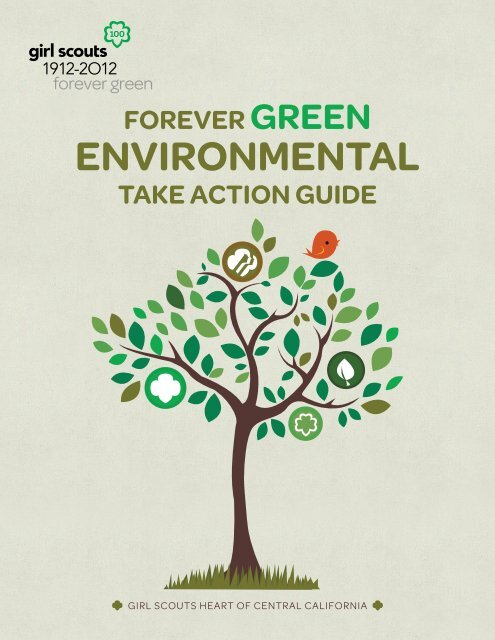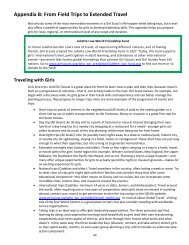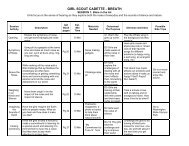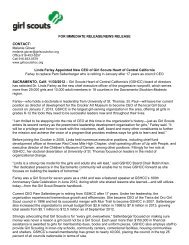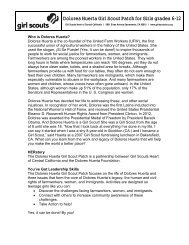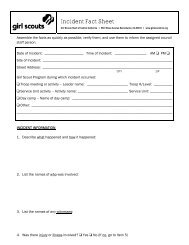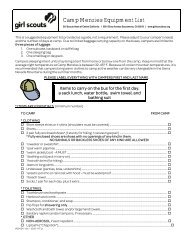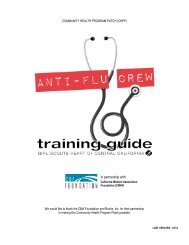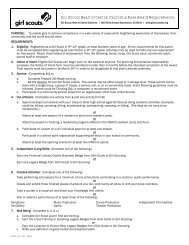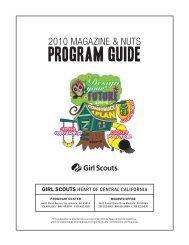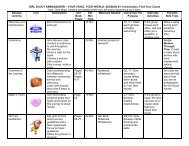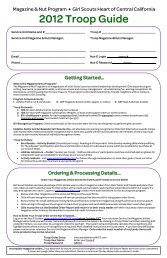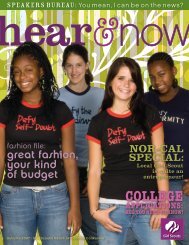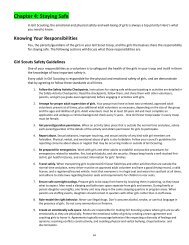the Forever Green Environmental Take - Girl Scouts Heart Of Central ...
the Forever Green Environmental Take - Girl Scouts Heart Of Central ...
the Forever Green Environmental Take - Girl Scouts Heart Of Central ...
Create successful ePaper yourself
Turn your PDF publications into a flip-book with our unique Google optimized e-Paper software.
forever green<br />
<strong>Forever</strong> <strong>Green</strong><br />
environmental<br />
take action Guide<br />
girl scouts heart of central california
Table of Contents<br />
I. <strong>Girl</strong> <strong>Scouts</strong> <strong>Forever</strong> <strong>Green</strong>—Community Action Project Overview ............................................................. 2<br />
II. Climate Change ......................................................................................................................... 4<br />
II. Focus Areas<br />
Brea<strong>the</strong> ...................................................................................................................... 6<br />
Don’t Just Throw It Away! .......................................................................................... 9<br />
WOW – Water Conservation .................................................................................... 13<br />
Energy Conservation ................................................................................................. 16<br />
Tree Planting and <strong>Environmental</strong> Action ................................................................. 19<br />
III. Additional Online Resources .................................................................................................. 23<br />
IV. <strong>Girl</strong> Scout Leadership Journeys .................................................................................... 26<br />
V. <strong>Girl</strong> Scout Badges .................................................................................................................... 27<br />
VI. Picking a Project .................................................................................................................... 34<br />
VII. Taking Action ....................................................................................................................... 36<br />
VIII. Connecting with Your Community ...................................................................................... 39<br />
1
<strong>Girl</strong> <strong>Scouts</strong> <strong>Forever</strong> <strong>Green</strong>: Community Action Project<br />
How green can YOU be???<br />
Use <strong>the</strong> information on <strong>the</strong> 100 th Anniversary section of <strong>the</strong> council Web site<br />
www.girlscoutshcc.org as a guide to determine if you would like to participate in an<br />
environmental action project as a troop/group or as an individual. You can also decide what<br />
type of project/s you would like to do. We are asking you to advocate for greener community<br />
areas – <strong>the</strong> rest is up to you and your passions and interests! There are a variety of<br />
environmental Focus Areas to choose from, including water use, energy efficiency, waste<br />
management, green spaces and air quality. See <strong>the</strong> following information more exploration of<br />
<strong>the</strong> focus areas, as well as specific project ideas. That list is only <strong>the</strong> beginning – you are free to<br />
create your own project to suit <strong>the</strong> needs of your community.<br />
According to surveys conducted by GSUSA, <strong>the</strong> environment is an incredibly important issue to<br />
<strong>Girl</strong> <strong>Scouts</strong>. We are thrilled about this opportunity because we know that <strong>the</strong> <strong>Girl</strong> <strong>Scouts</strong><br />
<strong>Forever</strong> <strong>Green</strong> Community Action Project will bring about lasting, sustainable, girl‐led change!<br />
It is also an excellent vehicle to showcase <strong>the</strong> <strong>Girl</strong> Scout Leadership Experience. At each grade<br />
level, <strong>Forever</strong> <strong>Green</strong> will give girls opportunities to explore <strong>the</strong> <strong>Girl</strong>s <strong>Scouts</strong>’ three keys to<br />
leadership—Discover, Connect, and <strong>Take</strong> Action.<br />
<strong>Girl</strong>s will first Discover <strong>the</strong>mselves and <strong>the</strong>ir values by seeking challenges in <strong>the</strong> world related to<br />
<strong>the</strong> environment. This means <strong>the</strong>y will, appropriate to <strong>the</strong>ir grade level, learn and explore new<br />
skills and ideas, and set challenging goals for <strong>the</strong>mselves.<br />
As girls assess <strong>the</strong> needs of <strong>the</strong>ir community with regard to environmental issues and <strong>the</strong>n<br />
pursue a specific project, <strong>the</strong>y will naturally Connect—care about, inspire, and team with o<strong>the</strong>rs<br />
locally and globally. Specifically, <strong>the</strong>y will promote cooperation and teamwork, and feel<br />
connected to <strong>the</strong>ir communities, locally and globally. As girls reach out to <strong>Girl</strong> Scout alumnae,<br />
parents, businesses, and o<strong>the</strong>r community and government leaders through <strong>the</strong>ir projects, <strong>the</strong>y<br />
will also advance diversity in a multicultural world.<br />
Through <strong>the</strong>ir chosen projects, girls will <strong>Take</strong> Action to make <strong>the</strong> world a better place. How?<br />
They will be resourceful problem solvers, advocating for <strong>the</strong>mselves and o<strong>the</strong>rs. They will also<br />
educate and inspire o<strong>the</strong>rs, in ways that aim for sustainable change. As <strong>the</strong> girls present <strong>the</strong>ir<br />
findings to <strong>the</strong>ir family, friends, and community partners, <strong>the</strong>ir advocacy efforts may influence<br />
community practices and policies. They will feel empowered to make a difference in <strong>the</strong> world.<br />
2
Who is eligible to participate?<br />
Any <strong>Girl</strong> Scout Troop, Juliette or individual girl registered in <strong>Girl</strong> <strong>Scouts</strong> <strong>Heart</strong> of <strong>Central</strong><br />
California.<br />
3
Climate Change and Global Warming 101<br />
In 1970, <strong>the</strong> very first Earth Day was held. The purpose of this new event was not only to<br />
celebrate but to also advocate and promote better stewardship of our planet. Now, as <strong>the</strong> 40 th<br />
anniversary of Earth Day approaches, <strong>the</strong> environmental movement has grown from a small<br />
event to a global issue. From celebrities to politicians to everyday people, <strong>the</strong> environment is an<br />
issue all <strong>the</strong> inhabitants of this planet care about. And all of us are looking for a way to help.<br />
Earth Day is March 26, 2011. See <strong>the</strong> program calendar for details on how you can celebrate<br />
Earth Day in your neighborhood, www. girlscoutshcc.org.<br />
Before we dive into what we can do, let’s do a little background on climate change, global<br />
warming and <strong>the</strong> related terminology. Information and graphic courtesy of<br />
www.epa.gov/climatechange/kids<br />
Wea<strong>the</strong>r:<br />
Wea<strong>the</strong>r is considered a short‐term condition. It changes in many places season to season,<br />
week by week, and day to day.<br />
Climate:<br />
Climate is different from wea<strong>the</strong>r because it is a long‐term condition. An area’s climate<br />
describes regional trends over many years and includes factors such as long‐term rainfall, wind<br />
patterns, sun intensity, and temperature.<br />
Climate Change:<br />
Climate change is a variation in <strong>the</strong> long‐term wea<strong>the</strong>r patterns. Scientists believe climate<br />
change over <strong>the</strong> last century can be attributed to global warming.<br />
Global Warming:<br />
Global warming is <strong>the</strong> process by which <strong>the</strong> Earth’s average surface, air, and ocean<br />
temperatures rise due to increasing amounts of greenhouse gases, which in turn causes<br />
changes in climate. This may include rainfall patterns, a rise in sea level, and a wide range of<br />
impacts on plants, wildlife, and humans.<br />
<strong>Green</strong>house Gases/<strong>Green</strong>house Effect:<br />
Some gases in <strong>the</strong> atmosphere trap <strong>the</strong> sun’s energy and cause <strong>the</strong> greenhouse effect. The five<br />
major greenhouse gases are water vapor, carbon dioxide, methane, nitrous oxide, and ozone.<br />
The greenhouse effect is important. Without <strong>the</strong> greenhouse effect, <strong>the</strong> Earth would not be<br />
warm enough for humans to live. But if <strong>the</strong> greenhouse effect becomes stronger, it could make<br />
<strong>the</strong> Earth warmer than usual. Even a little extra warming may cause problems for humans,<br />
plants, and animals.<br />
4
It may seem hard to believe that people can actually change <strong>the</strong> Earth’s climate. But scientists<br />
think that <strong>the</strong> things people do that send greenhouse gases into <strong>the</strong> air are making our planet<br />
warmer.<br />
The cars we drive, <strong>the</strong> way we heat our houses, cook our food and what products we buy all<br />
have an impact on <strong>the</strong> atmosphere. Knowing people are <strong>the</strong> cause is cause for hope. <strong>Girl</strong><br />
<strong>Scouts</strong> have a big role to play by committing to personal actions and behaviors, and by<br />
advocating for sound decision making to bring about climate change solutions. <strong>Environmental</strong><br />
sustainability, alternative transportation, reducing, reusing, recycling, composting, energy<br />
efficiency, renewable energy, carbon capture and storage, and responsible consumerism are<br />
some of <strong>the</strong> many ways <strong>Girl</strong> <strong>Scouts</strong>, can work toge<strong>the</strong>r to curb global warming and climate<br />
change. It may sound daunting, but all it really takes is commitment. And commitment comes<br />
from knowledge.<br />
The following pages provide information on <strong>the</strong> five focus areas of our <strong>Girl</strong> <strong>Scouts</strong> <strong>Forever</strong><br />
<strong>Green</strong> Community Action Project:<br />
Brea<strong>the</strong> (indoor and outdoor air<br />
quality)<br />
Don’t Just Throw it Away!<br />
WOW – Water Conservation<br />
Energy Conservation<br />
Tree Planting and <strong>Environmental</strong> Action<br />
Each section is designed to help you learn about each focus area, how it occurs and possible<br />
projects that can be a solution. But, don’t stop <strong>the</strong>re. Research and learn all you can about <strong>the</strong><br />
science and impact global warming and climate change is having on our planet. There are<br />
many online resources available where you can learn more about global warming, climate<br />
change and our focus areas. Several are included at <strong>the</strong> end of each focus area section. These<br />
resources can provide you with information, activities and ideas on how you can make a<br />
difference on <strong>the</strong> environment. We encourage all girls to utilize <strong>the</strong>se and o<strong>the</strong>r resources to<br />
increase <strong>the</strong>ir knowledge and become a better advocate for <strong>the</strong>ir project.<br />
We also have included information on how to develop an impactful project by examining your<br />
community and how to connect with your community to increase your impact!<br />
5
AIR<br />
Students spend six to seven hours every day breathing <strong>the</strong> air in school. According to <strong>the</strong> U.S.<br />
General Accounting <strong>Of</strong>fice, nearly 15,000 schools have air that is unfit to brea<strong>the</strong>. Improving <strong>the</strong><br />
air quality in and around your school improves your ability to brea<strong>the</strong> easy. Many schools have<br />
poorer air quality than office buildings due to chalk, bus idling, and lack of green space. Because<br />
poor air quality leads to asthma, allergies, and o<strong>the</strong>r illness, improving air quality is critical for<br />
<strong>the</strong> one in five people in <strong>the</strong> United States who spend <strong>the</strong>ir day in a school building. Household<br />
cleaners, pesticides, building materials, asbestos, fragrances, room deodorizers, and radon are<br />
all common sources of indoor air pollution. Outdoor air pollution from vehicles and industries are<br />
also damaging to human health and <strong>the</strong> natural environment. Improving air quality is a good<br />
way to prevent illness and improve <strong>the</strong> overall health and productivity of students.<br />
1. Indoor Air Quality<br />
Goals<br />
How?<br />
• Cleaner indoor air<br />
• Reduced asthma and allergies<br />
Project Examples Measure Your Project’s Impact<br />
Research <strong>the</strong> benefits of using green cleaning<br />
products. Talk to family and friends about<br />
using <strong>the</strong>se products.<br />
Educate people about <strong>the</strong> importance of<br />
clean indoor air in reducing allergies<br />
and asthma.<br />
Number of family and friends trained each year<br />
on green cleaning products.<br />
Number of people educated about clean air<br />
6
2. Outdoor Air Quality<br />
Goals<br />
How?<br />
• Increased carpooling<br />
• More trees<br />
• Cleaner outdoor air<br />
• Reduced school bus idling<br />
Project Examples Measure Your Project’s Impact<br />
Assess transportation patterns and encourage mass<br />
transit, carpooling, and bicycling.<br />
Campaign to turn off <strong>the</strong> engine of school buses and<br />
cars when unloading/loading at school and/or<br />
community areas.<br />
Decrease in number of vehicles coming<br />
to and from school or o<strong>the</strong>r place in <strong>the</strong><br />
community each day<br />
Decrease in number of minutes spent<br />
idling<br />
Plant native shrubs and trees. Number of new shrubs and trees planted<br />
Increase in number of different plant and<br />
animal species<br />
7
Resources<br />
www.epa.gov/iaq/schools: Tools and suggestions for improving air qualities within school<br />
buildings. There are resources about mold, caulk, and asthma. Within <strong>the</strong> Improve Air Quality<br />
“action kit” <strong>the</strong>re are documents that give specific steps to improve air quality in projects that<br />
are based in schools.<br />
www.epa.gov/cleanschoolbus: Clean School Bus USA is a program aimed at reducing children’s<br />
exposure to exhaust. This Web site has links to <strong>the</strong> national campaign to reduce bus idling, as<br />
well as outreach materials for <strong>the</strong> campaign.<br />
www.greenseal.org: The <strong>Green</strong> Seal is a nonprofit organization that sets environmental<br />
standards for products. This organization evaluates products’ compliance with standards and<br />
also enables consumers to see what products are <strong>Green</strong> Seal certified.<br />
www.greenguard.org: The <strong>Green</strong>guard <strong>Environmental</strong> Institute certifies satisfactory indoor air<br />
quality in buildings, schools, and construction sites. The resources include information about<br />
why indoor air quality is so important and links to articles that stress <strong>the</strong> importance of good<br />
indoor air quality in schools.<br />
www.airwatchnorthwest.org: Resources for outdoor burning programs and anti‐idling<br />
programs, including tips on how to reach out to schools and bus drivers. There are templates<br />
for letters that parents, students, and school officials can sign to make a pledge.<br />
www.earthday.net/noidling: The No Idling Campaign through <strong>the</strong> Earth Day Network is a great<br />
resource for <strong>Girl</strong> <strong>Scouts</strong> when conducting projects. There are also o<strong>the</strong>r helpful resources on<br />
<strong>the</strong> Earth Day Network Web site such as links to community campaigns and educational<br />
programs.<br />
www.earthforce.org/content/article/detail/1556: Earth Force has a long article about air quality<br />
including lists of air quality pollutants, an air pollution history timeline, and details about<br />
federal laws pertaining to air quality.<br />
8
WASTE MANAGEMENT<br />
Each one of us throws away approximately 4.6 pounds of waste per day! That means each week<br />
you throw away enough trash to equal more than 60 boxes of Thin Mints. We need to make<br />
good decisions in our daily consumption patterns and teach o<strong>the</strong>rs about reducing, reusing, and<br />
recycling, which are daily actions that make a big difference in how much waste we produce and<br />
how quickly we use <strong>the</strong> space in landfills. Composting helps clean up contaminated soil, prevent<br />
pollution, and create more space in landfills. Reusing consumer goods means that fewer new<br />
products need to be produced, thus saving energy. Helping to manage waste can also serve as a<br />
money earning activity for your project.<br />
1. Reduce<br />
Goals<br />
• Reduced greenhouse gases<br />
How?<br />
• Reduced purchase of food containers and reduced waste<br />
Project Examples Measure Your Project’s Impact<br />
Reduce quantities of disposable food and drink<br />
containers consumed.<br />
Reduce waste of weekly junk mail (for example,<br />
join <strong>the</strong> Catalog Canceling Challenge and contact<br />
mail sources).<br />
Reduce waste of bathroom supplies (for example,<br />
install hand driers in bathrooms).<br />
Print paper double‐sided (for example, adjust<br />
printer default for automatic double‐sided<br />
printing).<br />
Educate and advocate for reduced consumption of<br />
goods.<br />
Decrease <strong>the</strong> amount of trash produced (for<br />
example, encourage o<strong>the</strong>rs to recycle, reuse, and<br />
donate items and to buy items in minimal<br />
packaging).<br />
Reduced weight of weekly or monthly<br />
purchases of food containers<br />
Reduced weight of weekly junk mail<br />
and bathroom supplies<br />
Reduced weight of paper purchased<br />
per month<br />
Number of people educated about<br />
waste management<br />
Decrease in weight of trash sent to<br />
landfill per week<br />
9
2. Reuse and Recycle<br />
Goals<br />
How?<br />
• Decreased volume of waste and less impact on local resources and landfill space<br />
• More recycled aluminum cans, plastic, newspaper, paper, and electronics<br />
Project Examples Measure Your Project’s Impact<br />
Donate usable items—sporting goods, food,<br />
electronics, clothing, books, and furniture.<br />
Form a waste exchange to trade unwanted<br />
consumer goods.<br />
Start a compost program in your school, home, or<br />
community (check state regulations first).<br />
Reuse paper<br />
o Place trays or boxes for paper used on one<br />
side for o<strong>the</strong>rs to reuse before recycling.<br />
o Make notebooks by binding papers used on<br />
one side with cereal boxes.<br />
Weight of usable items donated<br />
Weight of items that are composted<br />
Reduced weight of paper purchased<br />
Educate people about benefits of recycling. Number of people educated about recycling<br />
Talk to your school administrators about<br />
starting/promoting recycling programs and<br />
install recycling bins in visible and convenient<br />
locations (for example, paper, cardboard,<br />
plastic, glass, aluminum cans, e‐waste, Capri<br />
Sun pouches, snack wrappers).<br />
Increase use of reusable water bottles by educating<br />
people about <strong>the</strong> benefits of reusing ra<strong>the</strong>r than<br />
throwing away.<br />
Talk to your school or community administrators<br />
about planning a Waste Reduction Week where<br />
events occur on <strong>the</strong>mes days (for example, Monday is<br />
Reduction Day, Tuesday is Compost Day, Wednesday<br />
is Zero Garbage Day, Thursday is Conservation Day,<br />
Friday is Reuse or Exchange Day and tie to national<br />
environmental events.<br />
Weight of items that are recycled—paper,<br />
aluminum, plastic, cell phones, e‐waste, and<br />
o<strong>the</strong>r products<br />
Number of people educated about water<br />
bottle waste<br />
Refer to metrics for each specific activity<br />
10
Resources<br />
www.greenschoolproject.com: This is a cartridge‐ and cell‐phone recycling program that<br />
partners with schools to promote recycling. There are also lesson plans and printable<br />
worksheets on <strong>the</strong> Web site.<br />
http://www.<strong>the</strong>recyclingguy.com: Program for recycling cell phones and o<strong>the</strong>r electronics in a<br />
safe way that benefits schools and charities financially.<br />
www.nikegamechangers.com/earth: Nike’s Reuse‐A‐Shoe program reuses shoes to construct<br />
playgrounds and athletic facilities. Troops or councils can apply to host a shoe drive in <strong>the</strong>ir<br />
community.<br />
www.stopjunkmail.org: Ways to reduce junk mail and remove your name from mailings. This<br />
Web site has templates for letters that you can write to catalogs and credit card offers to<br />
reduce junk mail.<br />
www.crirecylingink.com: CRI Recycling buys e‐waste including ink cartridges, cell phones, and<br />
ink jets that it <strong>the</strong>n recycles.<br />
www.nationalgreenweek.org and www.eeweek.org: Information about two national<br />
environmental weeks aimed at schools and communities and how to make <strong>the</strong>m greener. <strong>Girl</strong><br />
Scout projects can be featured on <strong>the</strong> Web sites. There are also videos, facts, and resources<br />
about <strong>the</strong> environment and waste.<br />
www.terracycle.net: Resource for upcycling Capri Sun pouches and o<strong>the</strong>r drink pouches as well<br />
as energy bar wrappers. These unrecyclable products are made into new products such as<br />
purses and pencil cases. Candy wrappers and snack wrappers can also be upcycled!<br />
www.thinkgreen.com: Waste Management’s Web site helps educate people about <strong>the</strong><br />
recycling process in a simplified and interesting way. Learn how waste is transformed to energy<br />
and how aluminum cans are recycled.<br />
www.howtocompost.org: A complete source of composting information and articles for<br />
beginners to experts, including educational resources for composting in schools, at home and in<br />
communities.<br />
www.freecycle.org: A grassroots nonprofit movement of people who are giving (and getting)<br />
items for free in <strong>the</strong>ir own towns, in an effort to reuse and keep items out of landfills.<br />
www.newdream.org: The Center for a New American Dream’s web site provides resources that<br />
helps Americans consume responsibly to protect <strong>the</strong> environment, enhance quality of life, and<br />
promote social justice. It includes a “green schools” section and highlights reusable water bottle<br />
efforts.<br />
11
www.catalogcancelingchallenge.com: The Catalog Canceling Challenge is a youth effort to<br />
cancel unwanted sales catalogs.<br />
www.kab.org: Keep America Beautiful is an organization that combines environmental<br />
education with hands‐on stewardship. This Web site provides a network for action projects and<br />
gives project suggestions.<br />
www.farmtoschool.org: Farm to Schools is a non‐profit organization that brings healthy local<br />
foods into schools and educates students about food, and how it travels from farm to fork.<br />
Learn about starting a farm to school program in your own school.<br />
12
WATER<br />
Each person uses 150 gallons of water a day on average. This translates into roughly 55,000<br />
gallons used per person every year. In a class of 25 students, <strong>the</strong> students use enough water<br />
each year to fill 2 Olympic‐sized swimming pools! If water consumption is reduced, that means<br />
that <strong>the</strong>re is more clean water for wildlife and you in <strong>the</strong> future. Two‐thirds of your body is<br />
nothing but water, which means that we don’t just use water, we are water! There is a finite<br />
amount of water on Earth, so we need to conserve clean water for future generations. Water<br />
can be recycled from cooling systems and irrigation systems and used more efficiently in<br />
buildings by using low‐flow shower heads and fixing leaky toilets. Promoting awareness of<br />
water consumption also help decrease water usage.<br />
1. Improve water quality<br />
Goal<br />
How?<br />
• Improved particulate count<br />
Project Examples Measure Your Project’s Impact<br />
Remove garbage and o<strong>the</strong>r waste from local<br />
lakes, rivers, or streams.<br />
Implement a plan to improve water quality by<br />
focusing on education and advocacy.<br />
Plant native shrubs and trees around water body<br />
to prevent erosion.<br />
Sand dune restoration.<br />
Weight of trash collected and removed<br />
from body of water<br />
Number of people educated<br />
Number of new plants, shrubs, and trees<br />
Number of square feet improved<br />
Increase in number of different plant and<br />
animal species<br />
13
2. Conserve water inside and outside of buildings<br />
Goals<br />
How?<br />
• Reduced water consumption<br />
• Reduced impact of water on municipality for water treatment<br />
Project Examples Measure Your Project’s Impact<br />
Campaign for people to reduce <strong>the</strong>ir shower<br />
time.<br />
Educate people about ways to reduce water<br />
consumption and pledge to reduce<br />
consumption.<br />
Replace shower heads, toilets, and faucets with<br />
low‐flow models.<br />
Irrigation controls, *xeriscaping of home front<br />
and back yards, and plant trees and native plants.<br />
*Xeriscape is a method of landscaping that<br />
promotes water conservation. It combines 7 basic<br />
landscaping principles: plan and design, soil<br />
amendment, efficient irrigation, appropriate plant<br />
and zone selection, mulch, alternative turf, and<br />
maintenance.<br />
Campaign and help school officials install plants<br />
that do not need lots of water.<br />
Total number of minutes by which shower<br />
time was reduced x 2.5 gallons per minute =<br />
reduction in total number of gallons of water<br />
Number of people educated<br />
Number of people who pledge to reduce<br />
<strong>the</strong>ir water consumption practices<br />
Reduction in number of gallons of water used<br />
Reduction in number of gallons of water used<br />
Number of new plants, shrubs, and trees<br />
Increase in number of different plant and<br />
animal species<br />
Number of new native plants, shrubs, and<br />
trees<br />
Build a rain garden. Number of square feet in garden<br />
Number of new plants<br />
Increase in number of different plant and<br />
animal species<br />
14
Resources<br />
www.girlscouts.org/program/gs_central/insignia/online/participation_patches/water_drop/ ‐ Water<br />
Drop Patch Project: A program resource, co‐produced by GSUSA and <strong>the</strong> EPA, that teaches <strong>Girl</strong><br />
<strong>Scouts</strong> about water quality and how to take action in <strong>the</strong>ir communities to protect and restore local<br />
water resources. Guidance on constructing rain gardens on school properties is included.<br />
www.epa.gov/safewater: The EPA has resources about water pollution, instructions on how to build<br />
rain gardens, and information about local water sources. This Web site includes links to publications<br />
about water conservation and ideas for promoting water efficiency.<br />
www.epa.gov/watersense/index.htm: Water Sense is an EPA partnership voluntary labeling<br />
program that offers consumers a simple way to make product choices that use less water with no<br />
sacrifice to quality or product performance.<br />
www.worldwatermonitoringday.org: World Water Monitoring Day is an international effort to<br />
improve water quality. There are test kits available to test <strong>the</strong> quality of local water sources.<br />
www.wateruseitwisely.com/100‐ways‐to‐conserve/index.php: This Web site lists 100 ways to<br />
conserve water. One of <strong>the</strong>se tips may spark a project idea.<br />
www.nwwater.com: The North Wales Water Authority provides information and facts about water<br />
and ideas for kids on how to conserve water. This Web site includes interactive games for kids about<br />
saving water and resources to teach children about water conservation.<br />
www.wetcity.org/resources.htm: Water Watchers: Conserving Water at Your School and Home,<br />
school water audit and conservation handbook, helps educators mentor a student‐driven audit of<br />
water use at school and in <strong>the</strong>ir homes. Lessons in <strong>the</strong> guide are arranged to lead students from<br />
awareness of basic water conservation issues to responsible action and stewardship of <strong>the</strong>ir water<br />
environment.<br />
www.projectwet.org: According to this Web site, “<strong>the</strong> mission of Project WET is to reach children,<br />
parents, educators, and communities of <strong>the</strong> world with water education.” There are numerous<br />
resources about water and water sources.<br />
www.bewaterwise.com: Tips for water conservation, drought resistant landscape ideas, and gardening guide.<br />
www.water.ca.gov/wateruseefficiency: Information about water conservation from landscaping, leak detection,<br />
irrigation and more.<br />
www.cuwcc.org: This non‐profit is a partnership of water suppliers, environmental groups, and o<strong>the</strong>rs interested<br />
in conserving California’s greatest natural resources, WATER.<br />
15
ENERGY<br />
Non‐renewable energy sources, such as oil and coal pollute <strong>the</strong> environment. Because air quality<br />
and health of people are severely impacted by non‐renewable energy sources, it is important to<br />
minimize <strong>the</strong> use of non‐renewable energy sources. Support usage of less energy in general and<br />
<strong>the</strong> use of renewable energy when possible. Renewable energy sources, such as solar and wind<br />
power, are cleaner and are replenished in a short period of time. The limitation<br />
of renewable energy sources is that <strong>the</strong>y rely on wea<strong>the</strong>r and may not be consistently available.<br />
1. Energy Conservation—Buildings<br />
Goals<br />
How?<br />
• Reduced energy usage<br />
Project Examples Measure Your Project’s Impact<br />
Create a project designed to reduce energy use at<br />
home and/or school (for example, use more energy<br />
efficient lighting and equipment, make small reminder<br />
signs to post near light switches and computers that<br />
say “turn off <strong>the</strong> lights” or “turn off <strong>the</strong> computer”).<br />
Work with your local power company to create a<br />
project to collect florescent light bulbs and exchange<br />
<strong>the</strong>m for CFL bulbs<br />
Educate people about energy usage and alternative<br />
and how to reduce <strong>the</strong>ir energy usage.<br />
Advocate for long‐term budgets to include solar panels<br />
or wind turbines.<br />
Decrease in energy use (kWh, BTUs,<br />
etc.)<br />
____________________________<br />
Number of light bulbs recycled and<br />
number of people educated about<br />
energy use<br />
____________________________<br />
Number of people educated about<br />
energy usage<br />
Increase in amount of renewable<br />
energy used (kWh, BTUs, etc.)<br />
16
2. Energy Conservation—Transportation<br />
Goals<br />
How?<br />
• More carpooling and bicycling<br />
• Less fuel used by school buses and cars<br />
• Lowered use of energy<br />
Project Examples Measure Your Project’s Impact<br />
Implement plan for conserving energy by changing<br />
transportation patterns.<br />
o Bike racks and bike paths<br />
o Carpooling program<br />
o Walking school buses<br />
Educate about alternative fuels and campaign to<br />
reduce energy usage, and/or ask people to sign a<br />
pledge to reduce <strong>the</strong>ir energy consumption.<br />
Plant trees and shrubs strategically to reduce heating<br />
and cooling costs.<br />
Educate people in <strong>the</strong> community about green vehicles<br />
which have higher than average mileage and produce<br />
fewer emissions.<br />
Decrease in number of vehicles<br />
coming to and from school or o<strong>the</strong>r<br />
place in community each day<br />
Number of people who are educated<br />
about reducing energy<br />
Number of people who sign a pledge<br />
to reduce <strong>the</strong>ir energy consumption<br />
Number of new plants, shrubs, and<br />
trees<br />
Number of square feet of new or<br />
improved green space<br />
Increase in number of different plant<br />
and animal species<br />
Number of people educated about<br />
greener vehicles<br />
17
Resources<br />
www.southface.org: South Face focuses on energy sustainability projects. Resources include<br />
designs for green buildings.<br />
www.energystar.gov/powermanagement: Energy Star standards require that electronics use<br />
less energy than federal efficiency standards. Councils can join campaigns to reduce energy<br />
consumed by refrigerators, telephones, and computers.<br />
www.usgbc.org: U.S. <strong>Green</strong> Building Council provides information about greening buildings and<br />
LEED certification. There is a link to Build <strong>Green</strong> Schools.<br />
www1.eere.energy.gov/buildings/energysmartschools: Schools are a great place to teach<br />
children about energy and <strong>the</strong> environment. This Web site includes suggestions on designing<br />
and building green schools.<br />
www.consumerenergycenter.org: Includes energy tips for schools, information about<br />
renewable energy, and transportation tips to reduce energy consumption.<br />
www.kidwind.org/lessons/teachers.html: Resources for teaching girls about renewable energy<br />
sources.<br />
www.windpoweringamerica.gov/schools.asp: Information about wind power in schools. This<br />
Web site also provides links for interactive activities and o<strong>the</strong>r resources about wind power.<br />
www.epeat.net: EPEAT helps consumers choose electronic products (computers) based on <strong>the</strong>ir<br />
environmental characteristics.<br />
www.focus<strong>the</strong>nation.org: Focus <strong>the</strong> Nation is a national teach‐in and policy agenda with a<br />
campaign to promote <strong>the</strong> civic engagement of youth.<br />
www.greenroofs.com: A resource portal for green roofs.<br />
www.fueleconomy.gov: The United States Department of Energy gives tips on vehicle energy<br />
usage and how to drive more efficiently.<br />
www.epa.gov/greenvehicles: The EPA’s guide to <strong>Green</strong> Vehicles help people chose fuel‐efficient<br />
vehicles to meet <strong>the</strong>ir needs. This information can serve as <strong>the</strong> basis of an educational session<br />
in <strong>the</strong> community.<br />
www.emoregon.org/pdfs/OIPL/OIPL_Kill_A_Watt_fact_sheet.pdf: This is a PDF file about how<br />
to use a Kil A Watt to save energy.<br />
www.energy.ca.gov: This Web site provides information about energy saving projects in California and<br />
ways to save energy in your home, school or business.<br />
www.smud.org/community&environment: Information about green buildings, shade trees and light bulb<br />
recycling programs<br />
18
TREE PLANTING<br />
AND<br />
ENVIRONMENTAL ACTION<br />
When environment‐based education was integrated into academic programs, test scores in<br />
reading, math, science, and social studies all improved, according to a study conducted in 2000<br />
by <strong>the</strong> National <strong>Environmental</strong> Education & Training Foundation. In addition, green spaces are<br />
an important asset to communities. Trees and o<strong>the</strong>r plants offer a beautiful, natural place for<br />
humans to relax and a habitat for a variety of animals and o<strong>the</strong>r organisms. They also provide a<br />
space for ga<strong>the</strong>ring, preserving <strong>the</strong> environment, and working toge<strong>the</strong>r as part of a healthy<br />
lifestyle. As few as 20 trees can offset <strong>the</strong> pollution from a car driven 60 miles per day. Trees<br />
also produce oxygen—<strong>the</strong> amount of oxygen produced by an acre of trees per year equals <strong>the</strong><br />
amount consumed by 18 people annually.<br />
Create green space and improve existing green space<br />
Goals<br />
How?<br />
• Increased square footage of usable green space<br />
• Increased number of student‐hours of green space use<br />
• Increased species diversity<br />
Project Examples Measure Your Project’s Impact<br />
Work with a local nursery to find out which<br />
plants grow best in your area. Plant native<br />
trees, shrubs, and flowers.<br />
Educate your community members about<br />
<strong>the</strong> benefits of creating and preserving green<br />
space.<br />
Number of new plants, shrubs, and trees<br />
Number of square feet of new or improved<br />
green space<br />
Increase in number of different plant and<br />
animal species<br />
Number of people educated about <strong>the</strong><br />
benefits of improving and maintaining green<br />
space<br />
New practices or policy changes made as a<br />
result of educating community members<br />
19
Start community or school vegetable<br />
gardens.<br />
Clean up trash in a local park or green<br />
space at your school.<br />
Develop a partnership with your nearest<br />
county, state or federal land management<br />
agency to clean up a trail or improve <strong>the</strong><br />
usability of a trail by spreading mulch or<br />
woodchips over <strong>the</strong> trail.<br />
Work with schools to plan activities that<br />
integrate curricula and green space.<br />
Develop and implement a National Trails Day<br />
or National Public Lands Day project.<br />
Create a tree planting event at a local<br />
park.<br />
Number of square feet of new green space<br />
Increase in number of different plant and<br />
animal species<br />
Volume of trash collected<br />
Number of square feet of green space<br />
improved<br />
Increase in number of student‐hours of green<br />
space use<br />
Number of square feet of green space<br />
improved.<br />
Number of square feet of green space<br />
improved.<br />
21
Resources<br />
www.mercedriverwatershed.org: Non‐profit who work with individuals and organizations to<br />
protect and enhance <strong>the</strong> natural, economic and cultural resources of <strong>the</strong> Watershed.<br />
www.epa.gov/greenscapes: Suggestions for cost‐efficient and environmentally friendly<br />
landscaping solutions. This Web site addresses composting, plants, green buildings and<br />
landscapes, and recycling.<br />
www.erthnxt.org/programs/trees21.html: This is an educational and tree‐planting toolkit. This<br />
Web site suggests science‐based activities for children ages 6–18 that reinforce <strong>the</strong> value of<br />
stewardship.<br />
www.edibleschoolyard.org: Edible School Yard is an example of an organic school garden in<br />
California. This Web site includes plans for gardens, recipes, and links to o<strong>the</strong>r Web sites about<br />
locally grown foods.<br />
www.slowfoodusa.org/index.php/programs/details/in_schools: Slow Food USA has examples of<br />
projects that meet community needs, such as cooking classes and school trips to local farms.<br />
www.lifelab.org: Life Lab gives tips for planting a school garden and has publications about<br />
school gardens.<br />
www.kidsgardening.org: Classroom project ideas, resource directory, and grant opportunities<br />
for kids’ gardens in <strong>the</strong> community.<br />
www.happeninhabitats.pwnet.org: This Web site is a great resource for learning about habitats<br />
and plants and includes suggested activities that are appropriate for elementary school–aged <strong>Girl</strong><br />
<strong>Scouts</strong>.<br />
www.eeweek.org/resources/garden_curricula: The National <strong>Environmental</strong> Education Week<br />
Web site offers lesson plans about gardening and green space for each grade level of <strong>Girl</strong><br />
Scouting.<br />
www.sactree.org: This non‐profit organization has a goal of planting 5 million trees in <strong>the</strong> next 15<br />
years and are partnering with our council to accomplish this goal. Check out <strong>the</strong>ir Web site and<br />
volunteer.<br />
www.treemodesto.org: Non‐profit dedicated to <strong>the</strong> development and protection of rural and<br />
urban forests in greater Modesto area.<br />
www.californiareleaf.org: Non‐profit whose mission is to empower grassroots efforts and build<br />
partnerships that preserve, protect, and enhance California’s urban and community forests.<br />
www.americanforest.org/global_releaf: Works with local partners to restore forest ecosystems.<br />
www.publiclandsday.org: NPLD is <strong>the</strong> nation’s largest hands‐on volunteer effort to improve and<br />
enhance <strong>the</strong> public lands Americans enjoy. Join us for <strong>the</strong> next NLPD on September 24, 2011.<br />
www.americanhiking.org: American Hiking Society’s signature trail awareness program, National<br />
Trails Day (NTD), inspires <strong>the</strong> public and trail enthusiasts nationwide to seek out <strong>the</strong>ir favorite<br />
23
trails to discover, learn about, and celebrate trails while participating in educational exhibits, trail<br />
dedications, etc. Join locally for <strong>the</strong> next National Trails Day, Saturday, June 4, 2011.<br />
www.treepartnerfoundation.org: To preserve and enhance <strong>the</strong> urban forest of <strong>the</strong> <strong>Central</strong> Valley.<br />
Friends of Trees of Nevada County: Non‐profit focused on <strong>the</strong> importance of trees, education<br />
about proper planting and maintenance of trees. Contact ellensol@succeed.net for more<br />
information.<br />
www.placertree.org: To increase public awareness of trees in <strong>the</strong> Placer County area, and to<br />
educate and assist <strong>the</strong> public in appropriate tree selection.<br />
www.rosevilletrees.org: To promote a healthy and perpetual urban forest in <strong>the</strong> Roseville area<br />
with education, tree planting and stewardship. Organization sponsors a variety of tree planting<br />
activities.<br />
www.caltrees.org: To support partners California communities involved in environmental<br />
education and concerned about <strong>the</strong>ir natural communities, especially forests.<br />
www.treedavis.org: Mission is to enhance and expand <strong>the</strong> City of Davis urban forest by inspiring<br />
people to plant and care for trees. Organization sponsors a variety of tree planting activities.<br />
www.woodlandtree.org: Dedicated to improving Woodland through <strong>the</strong> planting of trees.<br />
Organization sponsors a variety of tree planting activities.<br />
Additional Online Resources<br />
www.epa.gov/kids: The <strong>Environmental</strong> Protection Agency provides a great resource about<br />
natural resources, animals, and <strong>the</strong> environment. Certain information and Web site links (such<br />
as <strong>the</strong> links to virtual experiments) are geared toward younger girls, while o<strong>the</strong>r information<br />
and links to scholarships and career ideas are appropriate for older girls.<br />
www.sustainablesites.org: Sustainable Sites explains why sustainability is important by focusing<br />
on <strong>the</strong> ecosystem. The Web site includes descriptions of case studies of successful sustainability<br />
projects. The Orange County Great Park case study in California summarizes community<br />
participation, performance goals, and lessons learned from designing an environmentally<br />
sustainable park.<br />
www.buildgreenschools.org: Build <strong>Green</strong> Schools provides information about green schools<br />
including LEED standards. There are resources including power points and videos about<br />
recycling, school‐wide environmental projects, and energy‐efficiency strategies. O<strong>the</strong>r<br />
resources focus on K‐12 environmental education.<br />
www.loe.org/series/NCPHS: Producing radio shows about <strong>the</strong> environment is a fun project for<br />
older girls who can partner with a local radio station. Living on Earth is an independent<br />
environmental radio station, and its Web site offers links and examples of shows produced by<br />
24
students.<br />
www.bioneers.org/education: Bioneers Education Community gives examples of successful<br />
environmental education projects that create positive change.<br />
www.greenschoolsalliance.org/students/75ways.html: The <strong>Green</strong> School Alliance’s 75 Things<br />
You Can Do To Stop Global Warming is a great list of suggestions for living more sustainably<br />
that can inspire project ideas.<br />
www.nrdc.org: Natural Resources Defense Council has articles about current environmental<br />
issues, information on legislative policies, and resources for green living.<br />
www.sierraclub.org/education: Write about nature in <strong>the</strong> Sierra Club’s Words for Wilderness<br />
around <strong>the</strong> World project. There are links to educational organizations, environmental<br />
education resources, and information about youth awards.<br />
www.ase.org: The Alliance to Save Energy posts exciting news about <strong>the</strong> environment and<br />
relevant legislation. There is a link to <strong>the</strong> <strong>Green</strong> Schools Program that outlines ways to make<br />
schools more energy efficient.<br />
25
www.gogreeninitiative.org: Go <strong>Green</strong> Schools is a network for schools to help promote<br />
stewardship in <strong>the</strong>ir communities. There are also resources for schools such as recommended<br />
worms for composts. This Web site also has an article titled, “Why Go <strong>Green</strong>” that explains <strong>the</strong><br />
environmental, financial, and social benefits of living more sustainably.<br />
www.plt.org: Project Learning Tree is a Web site that helps students to learn “how to think, not<br />
what to think, about <strong>the</strong> environment.” This Web site has many helpful resources and<br />
information about each of <strong>the</strong> focus areas. There are also surveys about resource usage (such<br />
as water usage) so that girls can assess how much is being used and how usage can be reduced.<br />
www.earthsky.org: Earth Sky is a partner with Project Learning Tree. This Web site features<br />
downloadable podcasts that provide information about <strong>the</strong> environment and science.<br />
www.nwf.org/wildlife: The National Wildlife Federation helps protect wildlife and promotes<br />
sustainability for <strong>the</strong> future. This Web site provides information about animals and how <strong>the</strong><br />
focus areas connect to animal welfare and survival. For example, <strong>the</strong>re is an article about eagles<br />
and mercury pollution that may inform and inspire projects goals to protect wildlife.<br />
www.eco‐schoolsusa.org: Eco‐Schools USA is a part of <strong>the</strong> National Wildlife Federation and<br />
plans to launch its program in September 2009. This program helps schools become more<br />
sustainable and green.<br />
www.myfootprint.org: Individuals can calculate <strong>the</strong>ir carbon footprint by entering information<br />
such as number of people in household, size of household, number of miles traveled annually,<br />
and types of energy sources used.<br />
www.eo.ucar.edu/kids/green/index.htm: Kid’s Crossing: Living in <strong>the</strong> <strong>Green</strong>house, University<br />
Corporation for Atmospheric Research, provides kids with general scientific information about<br />
climate change and <strong>the</strong> environment<br />
www.howgreenismytown.org: How <strong>Green</strong> is my Town? provides information about climate<br />
change, sustainability, and environmental health at <strong>the</strong> local level.<br />
www.greeneducationfoundation.org: The <strong>Green</strong> Education Foundation is a nonprofit<br />
organization that strives to promote and enhance environmental education in schools. This<br />
foundation helps mobilize communities through National <strong>Green</strong> Week, <strong>Green</strong> Thumb<br />
Challenge, I Play <strong>Green</strong> Campaign, and o<strong>the</strong>r programs and campaigns.<br />
www.cnn.com/SPECIALS/2009/solutions: The CNN Web site has videos about solutions to<br />
environmental issues such as playgrounds made from recycled materials like milk jugs, tires,<br />
and sneakers.<br />
www.audubon.org: The National Audubon Center Web site provides environmental news and<br />
education. With more than 500 chapters around <strong>the</strong> country, this organization can create<br />
effective local connections for councils.<br />
26
http://www.epa.gov/adopt/linkinggirls/contacts.html:This is a contact list of <strong>the</strong> Linking <strong>Girl</strong>s<br />
to <strong>the</strong> Land federal natural resources and associated partners that may serve as potential<br />
partners for <strong>Girl</strong> <strong>Scouts</strong> <strong>Forever</strong> <strong>Green</strong> projects. These agencies collaborate with <strong>Girl</strong> <strong>Scouts</strong> at<br />
<strong>the</strong> national and local levels to connect girls to nature, wildlife and <strong>the</strong> outdoors and<br />
empower girls to take action through projects focused on environmental education, outdoor<br />
skills development, career exploration and service.<br />
25
<strong>Girl</strong> Scout Leadership Journeys<br />
Linking <strong>the</strong> <strong>Girl</strong> <strong>Scouts</strong> <strong>Forever</strong> <strong>Green</strong>—Community Action Project to Journeys<br />
Journeys are <strong>the</strong> core national <strong>Girl</strong> Scout program to be integrated in <strong>the</strong> development of <strong>the</strong><br />
<strong>Girl</strong> <strong>Scouts</strong> <strong>Forever</strong> <strong>Green</strong>—Community Action Project.<br />
How Are Journeys Integrated with <strong>the</strong> <strong>Girl</strong> <strong>Scouts</strong> <strong>Forever</strong> <strong>Green</strong>—Community Action Project?<br />
Dig into <strong>the</strong> journey books! Councils should use <strong>the</strong> journeys and <strong>the</strong>ir take action foundation<br />
as <strong>the</strong> core program content for <strong>the</strong> Community Action Project. Community Action Project<br />
planning can be integrated into journey activities.<br />
GSUSA provides support and encourages information sharing of successful strategies through<br />
one‐on‐one and group conference calls with councils, webinars, and <strong>the</strong> Basecamp Web site for<br />
<strong>the</strong> <strong>Girl</strong> <strong>Scouts</strong> <strong>Forever</strong> <strong>Green</strong>—Community Action Project pilot councils. Tips for using <strong>the</strong><br />
journeys are available on <strong>the</strong> journeys page of <strong>the</strong> GSUSA Web site at<br />
www.girlscouts.org/program/journeys.<br />
The It’s Your Planet—Love It! Planning Preview guide also serves as an excellent resource for:<br />
• Communicating intended leadership benefits for girls to volunteers, parents, and<br />
community partners.<br />
• Continuing to inform volunteers about how activities and <strong>Girl</strong> Scout processes work<br />
toge<strong>the</strong>r to achieve <strong>Girl</strong> Scout leadership outcomes.<br />
28
<strong>Girl</strong> Scout Brownie Try‐Its<br />
<strong>Girl</strong> Scout Badges<br />
These activities teach girls about <strong>the</strong> environment and help <strong>the</strong>m prepare for <strong>the</strong>ir community<br />
action projects. This list represents a sample of environmental activities from Try‐Its for<br />
Brownie <strong>Girl</strong> <strong>Scouts</strong>.<br />
Air<br />
Waste<br />
Management<br />
Water Energy<br />
<strong>Green</strong> Space<br />
Make it, Eat it <strong>Green</strong> Thumb<br />
Sports and<br />
Games<br />
Earth and Sky<br />
Earth is Our<br />
Home<br />
Sky<br />
Watching<br />
Clean and<br />
<strong>Green</strong><br />
Project Recycle<br />
Bicycling<br />
Stop a<br />
Draft<br />
Cooking<br />
with <strong>the</strong><br />
Sun<br />
Going, Going,<br />
Gone<br />
Can you Dig it?<br />
Earth’s Caretakers<br />
Eco‐Explorer Helping Wildlife<br />
Water<br />
Everywhere<br />
Be a Water<br />
Saver<br />
Water<br />
Explorer<br />
29
<strong>Girl</strong> Scout Junior Badges<br />
These badge activities will help educate girls about <strong>the</strong> environment and motivate <strong>the</strong>m to<br />
complete <strong>the</strong>ir community action projects. This is only a sample list. You can find o<strong>the</strong>r badges<br />
and activities in <strong>the</strong> Junior <strong>Girl</strong> Scout Badge Book.<br />
Humans and<br />
Habitats<br />
My Community<br />
<strong>Environmental</strong><br />
Health<br />
Earth<br />
Connections<br />
Eco‐Action<br />
Air<br />
Get <strong>the</strong><br />
Word Out<br />
(air quality<br />
in schools)<br />
Smoke<br />
Free<br />
Every<br />
Breath<br />
Counts<br />
You “Auto<br />
Know”<br />
Waste<br />
Management<br />
Helping Hands<br />
Earth as an<br />
Ecosystem‐consider<br />
problems with too<br />
much garbage for<br />
landfills<br />
Trashy Art<br />
Paper Rules<br />
Water Energy<br />
<strong>Take</strong> a Trip (to<br />
<strong>the</strong> local<br />
wastewater<br />
treatment)<br />
Water Water<br />
Everywhere<br />
Goin’ Fishing<br />
Every Drop<br />
Counts<br />
Outdoor Cook Test <strong>the</strong><br />
Waters<br />
What’s<br />
Watt<br />
Cook It<br />
<strong>Green</strong><br />
Space<br />
<strong>Take</strong> a Look<br />
Around You<br />
Make a<br />
Food Map<br />
Farmers<br />
Around <strong>the</strong><br />
World<br />
Make It<br />
Beautiful<br />
Get <strong>the</strong><br />
Lead Out<br />
Adapt or<br />
Perish<br />
Observing<br />
Change<br />
Plant a Tree<br />
30
Air<br />
Waste<br />
Management<br />
Outdoor Fun Clean Up<br />
Outdoors in <strong>the</strong><br />
City<br />
Protect <strong>the</strong><br />
Environment<br />
Water Energy<br />
Water Fun Precious Water<br />
Your Outdoor<br />
Surroundings<br />
Creative<br />
Solutions<br />
Local, National, and<br />
Global Problem<br />
Solving<br />
(ie: pollution)<br />
Oil Up How Does an Oil<br />
Spill Affect <strong>the</strong><br />
Beach?<br />
Come Clean<br />
Look Closely<br />
Build a<br />
Fire<br />
Cook<br />
with City<br />
Sun<br />
Ten?<br />
Twenty?<br />
<strong>Green</strong><br />
Space<br />
A City<br />
Garden<br />
Tackle a<br />
Community<br />
Service<br />
Project<br />
What does<br />
Minimal<br />
Impact<br />
Mean?<br />
31
<strong>Girl</strong> Scout Cadette, Senior, and Ambassador Interest Projects<br />
<strong>Girl</strong> can earn several Interest Project awards that focus on <strong>the</strong> environment. Here are some<br />
Interest Projects that can connect girls to <strong>the</strong> five environmental focus areas of <strong>the</strong> community<br />
action project. You can find o<strong>the</strong>r badges and activities in Interest Projects for <strong>Girl</strong>s 11–17.<br />
Air<br />
Waste<br />
Management<br />
Water<br />
Energy<br />
Car Sense X X<br />
Home Improvement X X X X X<br />
Travel X X<br />
Understanding Yourself and O<strong>the</strong>rs X X X X X<br />
All About Birds X X X X X<br />
Building a Better Future X X X X X<br />
Creative Cooking X<br />
Eco‐Action X X X X X<br />
From Shore to Sea X<br />
Planet Power X<br />
Plant Life X X X<br />
Architecture and <strong>Environmental</strong><br />
Design<br />
X X X<br />
Backpacking X X X X X<br />
X<br />
<strong>Green</strong><br />
Space<br />
X<br />
32
Guidelines for Success<br />
Keep it Simple: Choose a project that can be completed in a 3‐4 month period. Look over <strong>the</strong><br />
focus area charts, and choose a topic that you feel passionate about and that you think can be<br />
achieved in a short period of time.<br />
Make Connections: The more people you have participating in this project, <strong>the</strong> greater chance<br />
of success you have. Who are good people to include in your project? Obvious choices for<br />
connections might be a science class or an environmental club, but who else might want to<br />
help? What are different ways <strong>the</strong>y could be involved?<br />
For <strong>the</strong> Future: Will your solution fix something for <strong>the</strong> future or is it a one‐time project this<br />
spring? Are <strong>the</strong>re ways to make sure <strong>the</strong> solution lasts beyond your effort? Is this a project that<br />
can inspire all members of your community?<br />
As a council we have developed partnerships with many community, county, state and federal<br />
agencies who are excited to work with <strong>Girl</strong> <strong>Scouts</strong> on a variety of environmental needs. They<br />
are also happy to hear your ideas and see how <strong>the</strong>y can partner with you in order to complete<br />
your <strong>Take</strong> Action project.<br />
In <strong>the</strong> end, participants will not only have made a physical impact on <strong>the</strong>ir planet, but also an<br />
impact on <strong>the</strong>mselves and <strong>the</strong>ir community. They will have a deeper understanding of how <strong>the</strong>y<br />
make a difference and feel empowered to go out and make <strong>the</strong> world a better place.<br />
We look forward to seeing how you will make an impact!<br />
33
Picking a Project: Community and Causal Mapping<br />
You have explored <strong>the</strong> focus areas, utilized your resources and now you are ready to make an<br />
impact. But, you do not know where to begin? Trying to focus on just one aspect of such a large<br />
issue can be both intimidating and stressful. Don’t panic. We have included some tools to help you<br />
focus your passion and determine which focus area you can address with your project.<br />
One of <strong>the</strong> hardest question to answer is “who do I approach”? Communities are not single layer;<br />
<strong>the</strong>y have many different components and aspects that make <strong>the</strong>m unique. The first step you<br />
need to do is to examine your community and what makes is unique.<br />
Community can mean anything; <strong>the</strong> school you attend, <strong>the</strong> center you play sports at, <strong>the</strong> city<br />
you live in. It can also be <strong>the</strong> state you live in or even a national or global community. The<br />
question you need to ask yourself is “whom do I want to be my community for this project”?<br />
Many of you will say your school or community park or preserve. That is great. If you want to go<br />
larger and think on a city, state or global scale ‐‐‐ go for it! Once you have determined “your”<br />
community, you will create a map. Now this map is not like <strong>the</strong> ones in textbooks, but a visual<br />
representation of <strong>the</strong> components of your community. You will need paper to help you with this<br />
process. For example, let’s look at a sample community:<br />
1. Place your community in <strong>the</strong> middle (green circle)<br />
2. List your community’s parts (blue circles)<br />
3. List your community’s problems, which relate to an environmental issue (pink circles)<br />
4. Pick one problem from those listed to focus on and identify which focus area it falls under.<br />
Community Issue: Too much garbage not being recycled. Focus Area: Don’t Just Throw It Away<br />
34
Now that you have identified an issue in your community and its focus area, let’s look at <strong>the</strong><br />
causes of this particular issue. This is <strong>the</strong> second step in to creating a great project.<br />
Causal mapping is ano<strong>the</strong>r tool, similar to your community mapping tool. However, this map<br />
will focus on your issue. It is designed to help you identify causes for <strong>the</strong>se particular issues,<br />
possible solutions and o<strong>the</strong>r members of <strong>the</strong> community, who may be able to help you.<br />
Sticking with our community example, let’s examine <strong>the</strong> issue of garbage not being recycled.<br />
You can use <strong>the</strong> o<strong>the</strong>r side or your community map paper to do this process.<br />
1. Place your issues in <strong>the</strong> middle (Pink circle)<br />
2. List why you think this occurs. What causes <strong>the</strong> issue? (Tan circles)<br />
3. List what action could you take to help solve one of <strong>the</strong> causes (<strong>Green</strong> circles)<br />
4. List who at your community can help you put your solution into action. This can may include family,<br />
friends, community leaders and o<strong>the</strong>r organizations. (Yellow circles)<br />
CONGRATULATIONS!!<br />
You just identified your <strong>Girl</strong> <strong>Scouts</strong> <strong>Forever</strong> <strong>Green</strong> Community Action Project ideas!<br />
35
Taking Action: Creating a Sustainable and Lasting Project<br />
Now that you have identified your community, found your issue and identified a project, it is<br />
time to make a difference. But, before you dive in, you need to make sure that your project will<br />
be lasting and have an impact well beyond your actions.<br />
<strong>Girl</strong> <strong>Scouts</strong> <strong>Forever</strong> <strong>Green</strong> projects are more than just community service projects. They are an<br />
opportunity to make lasting change on an issue you feel passionate about. Sounds very<br />
intimidating, but it is not. Anyone can make lasting change if <strong>the</strong>y chose to make it lasting. One<br />
way to help you and your adult Project Advisors make this lasting change is through <strong>the</strong> <strong>Take</strong><br />
Action Learning Module. The o<strong>the</strong>r is connecting with those adults within “your community”<br />
who have <strong>the</strong> power to support your project and ensure its continuation. Let’s start with <strong>the</strong><br />
<strong>Take</strong> Action Learning Module.<br />
<strong>Take</strong> Action Learning Module<br />
The <strong>Take</strong> Action Learning Module is brand new enrichment training from GSUSA. It is designed<br />
to help adult volunteers and those who support volunteers, understand <strong>the</strong> <strong>Take</strong> Action<br />
component of <strong>the</strong> <strong>Girl</strong> Scout Leadership Experience. The module is specifically designed to<br />
assist volunteers and staff supporting girls in pursuit of <strong>the</strong>ir Bronze, Silver, and Gold Awards.<br />
However, it is also a fantastic tool for those working with participants on <strong>Girl</strong> Scout <strong>Forever</strong><br />
<strong>Green</strong> projects. The following are sections from this module.<br />
<strong>Take</strong> Action Key: What is it?<br />
The <strong>Take</strong> Action key and its corresponding outcomes (listed below) help girls become motivated<br />
and excited about making a long term impact in <strong>the</strong>ir community. <strong>Take</strong> Action encourages girls<br />
to think bigger and to address problems in such a way that <strong>the</strong>y do not reoccur. And, perhaps<br />
most important, a girl’s <strong>Take</strong> Action project changes <strong>the</strong> world in a meaningful way.<br />
• <strong>Girl</strong>s can identify community needs. In order for girls to start working on <strong>the</strong>ir award<br />
projects, <strong>the</strong>y must first find out what <strong>the</strong> community is in need of. <strong>Girl</strong>s also learn how<br />
to identify <strong>the</strong> root cause of <strong>the</strong> issue <strong>the</strong>y choose to address.<br />
• <strong>Girl</strong>s are resourceful problem solvers. Undoubtedly, <strong>the</strong>re will be roadblocks along <strong>the</strong><br />
way, which means that girls will need to come up with creative ways to solve <strong>the</strong><br />
problems that arise.<br />
• <strong>Girl</strong>s advocate for <strong>the</strong>mselves and o<strong>the</strong>rs, locally and globally. As <strong>the</strong>y learn about <strong>the</strong><br />
issues in <strong>the</strong>ir communities and work to solve <strong>the</strong>m, girls stand up for issues <strong>the</strong>y<br />
36
elieve in, influence policy, and identify ways to continue <strong>the</strong>ir project goals into <strong>the</strong><br />
future.<br />
• <strong>Girl</strong>s educate and inspire o<strong>the</strong>rs to act. By spreading <strong>the</strong> word about <strong>the</strong>ir experiences,<br />
girls educate o<strong>the</strong>rs about issues that are important to <strong>the</strong> community and inspire<br />
o<strong>the</strong>rs to act. This approach cannot help but have a positive effect on <strong>the</strong>ir<br />
communities.<br />
• <strong>Girl</strong>s feel empowered to make a difference in <strong>the</strong> world. <strong>Girl</strong>s develop leadership skills<br />
and use <strong>the</strong> knowledge <strong>the</strong>y gain through <strong>the</strong>ir experiences to improve <strong>the</strong>ir<br />
community…and <strong>the</strong> world!<br />
Overall, when <strong>the</strong> <strong>Take</strong> Action key is combined with <strong>the</strong> three Leadership Processes (“girl‐led”,<br />
cooperative learning and learning by doing), <strong>the</strong> <strong>Take</strong> Action projects not only have an impact<br />
on <strong>the</strong> community, <strong>the</strong>y will have an impact on <strong>the</strong> participants.<br />
<strong>Take</strong> Action vs. Community Service Projects<br />
There is difference between Community Service and <strong>Take</strong> Action project. While both contribute<br />
to <strong>the</strong> community, <strong>Girl</strong> <strong>Scouts</strong> <strong>Forever</strong> <strong>Green</strong> projects are looking for a longer, lasting impact<br />
that comes from a <strong>Take</strong> Action project. The definitions below are to help you determine if your<br />
project is Community Service or <strong>Take</strong> Action:<br />
Community Service Project:<br />
Community service projects address an immediate need in <strong>the</strong> community. For example, girls<br />
may organize a book or clothing drive, paint walls to cover up graffiti, or hold a one‐time march<br />
or fair to highlight a community problem. Although <strong>the</strong>se projects address a need in <strong>the</strong><br />
community, <strong>the</strong>y do so for only a short period of time.<br />
<strong>Take</strong> Action Project:<br />
A <strong>Take</strong> Action project picks up from where a short‐term project leaves off. For example, <strong>the</strong><br />
girls organizing <strong>the</strong> book or clothing drive could make <strong>the</strong>ir project a <strong>Take</strong> Action project by<br />
holding <strong>the</strong> drive annually and getting a sponsor to advertise and organize it every year. The<br />
girls who painted <strong>the</strong> walls to cover up graffiti can create a club that travels around <strong>the</strong> city<br />
painting beautiful murals on buildings that have been defaced. And <strong>the</strong> girls who held <strong>the</strong><br />
march or fair could expand <strong>the</strong> event to include community artisans and make it an annual<br />
ga<strong>the</strong>ring. For each project, girls can publicize and get people in <strong>the</strong> community to come out<br />
and support. They can even get community leaders involved.<br />
37
When girls pursue <strong>Take</strong> Action projects, <strong>the</strong>y take time to identify and understand <strong>the</strong> root<br />
cause of <strong>the</strong> issue <strong>the</strong>y are addressing. Also, in a <strong>Take</strong> Action project, girls develop <strong>the</strong> project<br />
to be sustainable and have an impact that is measurable. Because <strong>the</strong>se two words are vague<br />
and difficult to define, we have included definitions below:<br />
• Measurable: The success of <strong>the</strong> project can be determine based on <strong>the</strong> number of<br />
people <strong>the</strong> project helped, <strong>the</strong> number of people who were involved, any reduction in<br />
<strong>the</strong> community’s need, and o<strong>the</strong>r concrete numbers.<br />
• Sustainable: <strong>Girl</strong>s must make arrangements (such as collaborating with community<br />
leaders and/or organizations; building alliances with mentors) to ensure that <strong>the</strong> project<br />
creates lasting change and is not a one‐time event.<br />
The table below is a great resource for you when determining what <strong>Take</strong> Action can do for <strong>the</strong><br />
community and <strong>the</strong> roles for participants.<br />
For girls:<br />
• Empower girls<br />
• Open <strong>the</strong>ir eyes to a bigger world<br />
• Own <strong>the</strong>ir projects; raise <strong>the</strong> quality of projects<br />
• Inspire o<strong>the</strong>rs<br />
• Know <strong>the</strong>y can make a difference<br />
• Increase <strong>the</strong>ir self‐esteem<br />
• Gain exposure to o<strong>the</strong>rs and <strong>the</strong>ir viewpoints<br />
• Improve leadership skills<br />
• Develop life skills<br />
• Develop collaboration skills<br />
• Develop problem‐solving skills; troubleshoot<br />
<strong>Girl</strong>’s role:<br />
• Hear <strong>the</strong> <strong>Take</strong> Action message; take<br />
responsibility for <strong>the</strong> quality of her project<br />
• <strong>Take</strong> advantage of grade‐level‐appropriate<br />
learning opportunities<br />
• Ask for help when needed<br />
• Be willing to make mistakes<br />
• Support her peers<br />
• <strong>Take</strong> healthy risks and think outside <strong>the</strong> box<br />
• Educate herself and o<strong>the</strong>rs on current issues<br />
(global and personal)<br />
• Use modern tools<br />
• Practice public speaking<br />
• Approach people for help or information<br />
• Define what leadership means to her<br />
• Use her adult resources to help streng<strong>the</strong>n<br />
projects<br />
• Define <strong>the</strong> Promise and Law for herself<br />
What <strong>Take</strong> Action Can Do<br />
For volunteers:<br />
• Improve facilitation skills<br />
• Increase self‐confidence<br />
• Create richer experience when interacting with girls<br />
• Increase retention of volunteers<br />
• Empower volunteers<br />
• See value of <strong>the</strong>ir time investment<br />
• Find <strong>the</strong>ir niche<br />
• Streng<strong>the</strong>n bonds between girls and adults<br />
• Deepen knowledge of community<br />
• Create sense of accomplishment<br />
Definition of Roles<br />
Volunteer’s role:<br />
• Be open to change and present <strong>the</strong> changes positively<br />
• Expect quality <strong>Take</strong> Action projects<br />
• Let <strong>the</strong> girl lead<br />
• Learn with <strong>the</strong> girls; accept help<br />
• Value girls; encourage <strong>the</strong>m; celebrate success; learn from mistakes<br />
• Share <strong>the</strong> girls’ stories; teach girls to be proud of <strong>the</strong>ir successes<br />
• Stay up‐to‐date with resources<br />
• Know who to go to for help in <strong>the</strong> community and GS<br />
• Attend <strong>Take</strong> Action Learning Module<br />
• Recruit more volunteers<br />
• Know her own style of leadership<br />
• Work as a team<br />
• Remember <strong>the</strong> Promise and Law<br />
• Be an advocate for girls; help girls be advocates for <strong>the</strong>mselves<br />
• Communicate with girls and adults<br />
• Help girls evaluate and measure progress<br />
38
For more in‐depth training on <strong>the</strong> <strong>Take</strong> Action Learning Module, please check out <strong>the</strong> council<br />
Web site www.girlscoutshcc.org to see when <strong>Take</strong> Action courses are being offered.<br />
Connecting with Your Community<br />
Your issue is determined, your project clear and you are ready to <strong>Take</strong> Action. Now, you just<br />
need to connect with those who have <strong>the</strong> ability to make your plan a reality. From your casual<br />
map exercise, you probably identified a few o<strong>the</strong>r groups within “your” community who have<br />
<strong>the</strong> knowledge, power or guidance you need for your project. These are your Project Advisors.<br />
Generally, <strong>the</strong>se adults are <strong>the</strong> contact person for <strong>the</strong> school, organization or “your”<br />
community, which will help you with your project. These are <strong>the</strong> individuals who will provide<br />
<strong>the</strong> Letter of Support for your project, provide guidance regarding <strong>the</strong>ir capabilities and will<br />
help to ensure your project is sustainable and impactful.<br />
While approaching “your” chosen community may seem very scary and intimidating, it is very<br />
easy. Here are some tips to help. If you need more, contact your service unit liaison or<br />
100@girlscoutshcc.org for additional tips:<br />
1. Contact “Your” Chosen Community:<br />
You have already identified potential contacts through your community and causal maps.<br />
Some of <strong>the</strong>se contacts may be people or organizations. There is a list of community<br />
resources on <strong>the</strong> 100 th section of <strong>the</strong> council Web site who are willing and excited to help<br />
you with your project. Email <strong>the</strong>m today and create a partnership in your community.<br />
2. Set up a Meeting:<br />
Oprah Winfrey may set thing in motion with a phone call, but she closes <strong>the</strong> deal face to<br />
face. Set a time up with your contact to discuss your project. Be sure to be on time and<br />
bring a list of potential questions, including rules, safety, contact info and potential<br />
volunteers. Be prepared to talk about what <strong>Girl</strong> Scout <strong>Forever</strong> <strong>Green</strong> is, what your project is<br />
and what you need from <strong>the</strong>m. It is always a good idea to have an adult with you, but<br />
remember <strong>the</strong>se are “girl‐led” projects. If <strong>the</strong>y agree, be sure to ask <strong>the</strong>m for a Letter of<br />
Support for your project.<br />
3. Communicate:<br />
Now that you have your Project Advisor in place, it is important in this whole process for<br />
you to keep everyone in <strong>the</strong> information loop. Set up an update schedule (weekly, monthly)<br />
39
with all involved parties. This way, you can keep tabs not only on your project progress, but<br />
also <strong>the</strong> impact your project is making. Also be sure to have current email addresses.<br />
4. Promote and Education:<br />
Be sure to promote your project to your community. This can be friends, family,<br />
schoolmates, o<strong>the</strong>r organizations and <strong>the</strong> media. <strong>Girl</strong> <strong>Scouts</strong> <strong>Forever</strong> <strong>Green</strong> projects not<br />
only make a physical impact, but an individual impact by helping to advocate for <strong>the</strong><br />
environment. We want you to invite o<strong>the</strong>rs to help you and also educate <strong>the</strong>m on why it is<br />
important to be a better steward of <strong>the</strong> environment. You can do informational nights for<br />
volunteers or educational workshops for kids. You can also submit a story to your<br />
community media. Your options are endless. Knowledge is power and we want you to share<br />
yours to make <strong>the</strong> world a better place. If you want to share your story with media, please<br />
contact MarComm@girlscoutshcc.org for assistance.<br />
5. Document:<br />
We want to know what you are doing and about your successful project. When you<br />
complete your project, click here and complete <strong>the</strong> project form. This is YOUR place to<br />
share your successes and see what o<strong>the</strong>r <strong>Girl</strong> <strong>Scouts</strong> are doing to make California forever<br />
green. Check back frequently to see <strong>the</strong> environmental impact <strong>Girl</strong> Scout <strong>Forever</strong> <strong>Green</strong> is<br />
making in Nor<strong>the</strong>rn California.<br />
Are you ready to be GREEN?<br />
At <strong>the</strong> beginning of this guide, we asked “how green can you be”? Perhaps you were unsure.<br />
Maybe you felt uneasy about working on a project. Or, maybe you are ready to go out and<br />
make <strong>the</strong> world a better place. Regardless, you are now ready to go out and make your passion<br />
a reality and really be <strong>the</strong> change you want to see in <strong>the</strong> world. There is a Native American<br />
saying, “We do not inherit <strong>the</strong> earth. We are merely guardians for our children.” Are you ready<br />
to go out and leave <strong>the</strong> earth better than you found it? After all, that’s what <strong>Girl</strong> <strong>Scouts</strong> do.<br />
40


